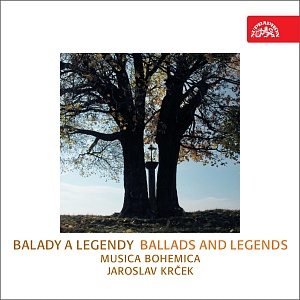
MUSICA BOHEMICA TO RELEASE ANNIVERSARY ALBUM 'BALLADS AND LEGENDS'
AN INTERVIEW WITH JAROSLAV KRČEK


“I am the founder of Musica Bohemica, an ensemble I have headed for some four decades. And other activities of mine, especially in the domain of art music, have been alive in Musica Bohemica since the very beginning,” says Jaroslav Krček.
Musica Bohemica’s debut recording for Supraphon was Dřevo se hudbou odívá (Wood Attired in Music), released back in 1979. The LP features several forcible folk texts, to which Jaroslav Krček composed music of such sensitivity that many a listener still considers it folk tunes. The next Musica Bohemica album, České a moravské lidové balady (Czech and Moravian Folk Ballads), includes traditional melodies in Krček’s arrangements, imbued with his singular signature and colourful instrumentation. Jaroslav Krček also proved to be sure-footed when selecting the soloists; one would be hard pressed indeed to imagine better delivery.
The anniversary album, titled Ballads and Legends (SU 4191–2), to be released on 18th September 2015, features pieces cherry-picked from the two early recordings, with some of them being released on CD for the very first time. The songs that have enchanted generations of Musica Bohemica listeners now come across in their full beauty again.
AN INTERVIEW WITH JAROSLAV KRČEK:
What inspired you to establish the ensemble, initially in 1967 as Chorea Bohemica, renamed in 1975 Musica Bohemica?
I felt the urge to form an ensemble who would perform the historical musical legacy in a new arrangement. First we concurred that our aim would be to present on stage folk songs in concert versions. So we conformed to it the arrangements and the overall rendition of the folk music. Yet soon we strove to get deeper into the traditional heritage, immersing ourselves into the older layers. Thus we entered the domain of Baroque and then went even further back, to Gothic and Renaissance. Suddenly we came upon new discoveries, not only as regards singing and dancing, but also in textual terms, as a result of which Chorea Bohemica became a unique ensemble. At the time, I worked in tandem with the choreographer Alena Skálová, with whom I shared an identical sentiment. We used to dub her the “Czech Antonio Gades”, after the feted Spanish creator of stage dance art.
Did you approach folk creation as an original, respecting its authenticity in the historical form, or did you, as against academic stuffiness, strive to place emphasis on the spontaneity of its performance?
I dipped into everything, and I also ventured on the authentic form of folklore. That was immediately after arriving in Prague, when I formed the Small Band within Ladislav Vycpálek’s ensemble. In this band, I also played the double-bass and sang. We called it “raw wood”. After some time, I moved on, towards stylisation, while maintaining spontaneity and communicativeness. It was clear to me that first and foremost I had to imbibe folk art in its authentic form, process it for myself, so as to make my live performance credible. And this has actually continued up to the present day.
What was the reason for the separating of Musica Bohemica from Chorea Bohemica?
It was simple. Chorea Bohemica was an amateur ensemble and we had difficulties with asserting ourselves on concert stages. We had no patron and only managed to give a single premiere a year. Eight years down the road, I arrived at the conclusion that a professional ensemble had to be set up. For a short time, we went on performing as Chorea Bohemica, but then, in 1977, we were provided patronage by the Prague Symphony Orchestra, under their brilliant director, Ladislav Šíp. My brother Josef and the flautist Vladimír Krafl were joined by the Pospíchal brothers: the violinist Jan, today a concert master of the Wiener Symphoniker, and the violist Jiří, a member of the Mozarteum in Salzburg. The line-up was supplemented by the violinist Jan Buble, a member of the Czech Philharmonic Orchestra, and my double-bass was joined by a harp, oboe, clarinet, bassoon and, naturally, singers. At that time, the ensemble was given a new name: Musica Bohemica. Our association with the Prague Symphony Orchestra lasted until 1993.
Your catalogue of compositions for Musica Bohemica contains 65 original works and 548 arrangements. Up to the present day, you have performed 102 programmes, 839 folk songs, 102 contemporary and 172 historical pieces. In addition, you have also recorded 17 LPs, 50 CDs, not to mention undertaking numerous projects for radio, television, film and theatre…
That is right, even though I myself can hardly believe it. The ensemble’s configuration has changed little, hence we have been able to concentrate on improving the quality of our performance. Musica Bohemica is currently a chamber ensemble made up of 11 members, performing music ranging from Baroque through folk and anonymous creations to contemporary works.